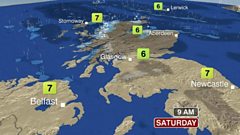
18/01/2013
Mel Giedroyc presents the final chapter of this week's story, 'Dustbin Baby' by Dame Jacqueline Wilson, and more everyday science with Dick and Dom in How Dangerous Is Your Garden.
Last on
Clip
-
![]()
Dick and Dom: Weather
Duration: 11:57
Chapters
-
How Dangerous Is Your Garden – Part 5
Dick and Dom are investigating the science behind the weather, asking what makes rain, how does a greenhouse work and why can some plants stand up to Jack Frost while others can’t?
Duration: 12:51
Dame Jacqueline Wilson - My Life In Five Books – Part 5
The celebrated novelist chats to presenter Stuart Cosgrove about her favourite childhood book Nancy and Plum by Betty MacDonald.
Duration: 03:49
Wheelie Bin Art – You and Yours
Artist Isabel Hill and Councillor Heidi Alexander discuss how you can beautify your bin.
Duration: 03:11
Magical Mystery Tour – Ashdown Forest
Presenter Mat Baker takes a tour of the forest that inspired Winnie-The-Pooh’s home, the Hundred Acre Wood.
Duration: 08:38
Dustbin Baby – Part 5
The final part of Dame Jacqueline Wilson’s story about April, the 14 year old girl who was abandoned in a dustbin as a newborn and her search for her real mother.
Duration: 22:35
Activity 1. Create your own rain
This activity requires adult assistance, as it involves holding an object in hot steam from a kettle.
��
You will need:
- A metal baking tray that’s been in your freezer for an hour
- A kettle
- Heat resistant gloves (eg oven gloves)
First boil the kettle so that the water in it is already hot. Now take the baking tray out of the freezer, and get your adult helper to put their gloves on.
��
Turn the kettle on, and when it reaches boiling point, keep the switch pressed in so that it continues to bubble and create steam. Get your adult to hold the baking tray horizontally above the spout from the kettle, 10-20cm above it.
��
As the steam hits the cold metal, you should see condensation appear, which will then drip down, just like rain. What’s happening?
��
You’ve just created a mini water cycle. The water that started out in the kettle, changed into water vapour when it was boiled. Then when this water vapour was cooled down by hitting the baking tray, it turned back into liquid and dripped down.
��
In nature, this represents the way that water on the ground such as in puddles or lakes is warmed by the Sun and evaporates into that air. High up in the atmosphere it’s very cold, so the water vapour turns back into liquid, which falls down as rain once the rain drops get too large for the air currents in the clouds to support. When the water vapour is beginning to form drops but they’re not heavy enough to fall, you get clouds.
Activity 2. How to make a greenhouse
Greenhouses enable gardeners to grow a much greater variety of plants through a longer period of the year and produce fruit and vegetables that are ripe and juicy. A greenhouse doesn’t just keep the rain out, it also warms the air up inside, which is great for plant growth. This happens because glass or plastic allows the energy from the Sun to enter, but it doesn’t let it back out, so the air inside the greenhouse warms up.
��
You can create your own mini greenhouse to test out this for yourself.
You will need:
- A 2 litre bottle
- A piece of cardboard
- Sticky tape
- Two small thermometers.
- A sunny day OR a desk lamp
Cut the end off the bottle so that you can place the thermometer inside. Cover the hole with the cardboard and seal it up. Now place the bottle in a sunny position with the thermometer inside visible, and lie the other thermometer in the open air next to it.
��
Watch both thermometers. The temperature inside the greenhouse should soon begin to rise…
��
If it’s not sunny you can use a desk lamp instead of the Sun. What’s happening?
��
The light from the Sun goes through the plastic bottle and is absorbed by the air and any plants inside. The contents of the bottle return the sunlight they have absorbed as invisible infrared light. Infrared light is heat – like the heat�� you feel from a radiator before you touch it. Unlike normal light, infrared light can't get through the plastic bottle, so the bottle heats up, keeping our plants warm even if it's cold outside!
Activity 3. Greens in the freezer
Frost can destroy some plants, but doesn’t affect others. Here’s an experiment that demonstrates this very clearly, and mushily!
You will need:
- Various types of salad leaves from the supermarket, such as lettuce or rocket
- Some grass from your garden or local park
- A freezer
Put the salad leaves and the grass into the freezer and leave them there for a few hours. Then take them out, let them warm up, and examine them closely. You’ll see that some of the plants have survived better than others. Plants like lettuce will have disintegrated into what Dick and Dom and their helpers described as ‘glob’! The grass however survives intact, looking much the same as it did before it was frozen. What’s happening?��
When it gets frosty, ice crystals form inside plants and can burst the plant cells, destroying the structure, and making the leaves go mushy. This is what you see with the lettuce leaves. That’s why lettuce only grows in the spring and summer months – it can’t survive outside in winter.
��
Plants like grass are adapted to frost and are much hardier, so they can grow all year round. They have evolved with several defences against the cold and have tougher structures to withstand the formation of ice crystals. Some plants even contain a form of anti-freeze which stops the ice crystals forming in the first place.
Broadcast
- Fri 18 Jan 2013 16:0091�ȱ� Radio 4 Extra

